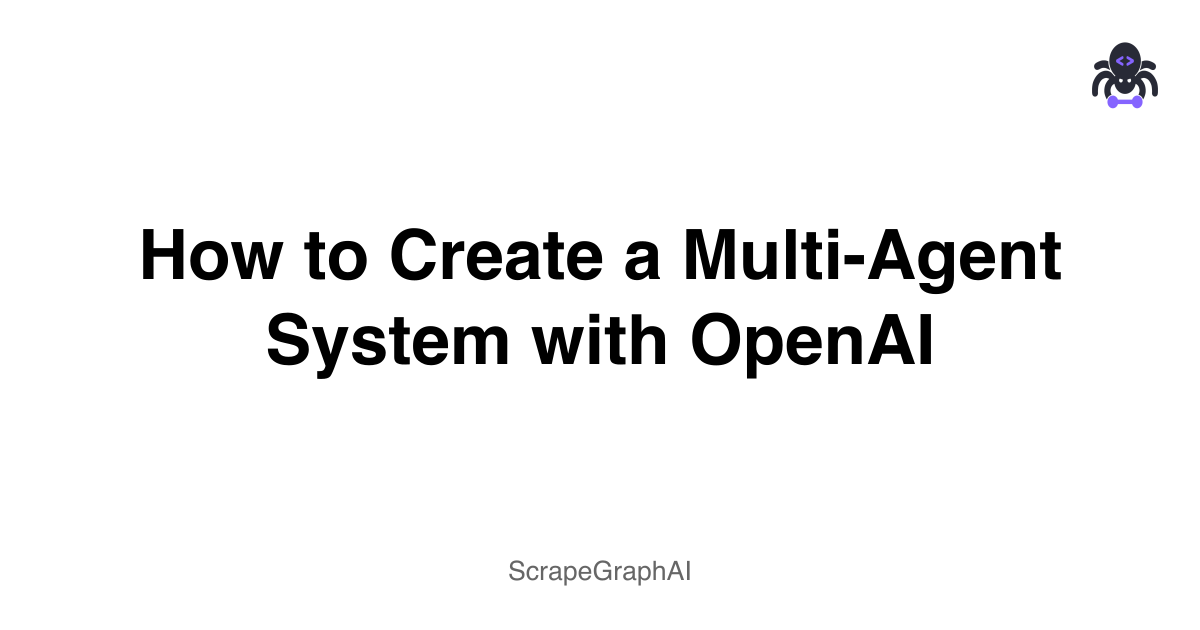If you want to build a basic multi-agent system without relying on heavy frameworks like LangGraph or CrewAI, you can create it from scratch using just the official OpenAI Python SDK.
This approach is perfect for learning how agents can communicate, coordinate tasks, and specialize, using prompt engineering and Python logic alone. For a more advanced implementation using frameworks, check out our guide on building multi-agent systems with LangGraph, CrewAI and LlamaIndex.
🤖 What is a Multi-Agent System?
A multi-agent system (MAS) consists of multiple AI agents working collaboratively or independently to solve problems. Each agent has its own:
- Role or specialization
- Goal or task
- Communication interface (how it exchanges information)
In this tutorial, we build a minimal MAS where agents send messages to each other through a simple Python orchestrator, all powered by OpenAI GPT models. For more advanced agent implementations, see our guides on AI Agent Web Scraping and building intelligent agents with ScrapeGraph.
🛠️ Prerequisites
Make sure you have the OpenAI Python library installed:
pip install openaiSet your API key as an environment variable:
export OPENAI_API_KEY="your-openai-api-key"1. Define Your Agents as Python Classes
Each agent will have a role, and a method to generate responses based on input messages.
import os
import openai
openai.api_key = os.getenv("OPENAI_API_KEY")
class Agent:
def __init__(self, name, role_description):
self.name = name
self.role = role_description
self.history = []
def send_message(self, message):
# Store incoming message
self.history.append({"role": "user", "content": message})
# Generate agent's reply using OpenAI
response = openai.ChatCompletion.create(
model="gpt-4o-mini",
messages=[
{"role": "system", "content": f"You are an AI agent named {self.name}. Your role: {self.role}."}
] + self.history
)
reply = response.choices[0].message.content.strip()
# Store agent reply in history
self.history.append({"role": "assistant", "content": reply})
return reply2. Instantiate Your Agents
Create a few agents with different specializations.
researcher = Agent(
name="Researcher",
role_description="Finds and summarizes the latest technology trends."
)
analyst = Agent(
name="Analyst",
role_description="Analyzes research data and provides actionable insights."
)3. Build the Orchestrator to Make Agents Talk
We simulate a conversation where the Researcher gathers info, then sends it to the Analyst for interpretation.
def multi_agent_workflow():
print("Starting multi-agent workflow...\n")
# Step 1: Researcher collects info
researcher_message = "Please summarize recent breakthroughs in AI."
print(f"[User -> Researcher]: {researcher_message}")
research_output = researcher.send_message(researcher_message)
print(f"[Researcher]: {research_output}\n")
# Step 2: Analyst receives summary and analyzes it
print(f"[Researcher -> Analyst]: {research_output}")
analysis = analyst.send_message(f"Analyze this research summary and provide insights:\n{research_output}")
print(f"[Analyst]: {analysis}\n")
multi_agent_workflow()4. Output Example
[User -> Researcher]: Please summarize recent breakthroughs in AI.
[Researcher]: Recent breakthroughs in AI include advances in large language models, reinforcement learning, and multimodal AI that can process images and text simultaneously.
[Researcher -> Analyst]: Recent breakthroughs in AI include advances in large language models, reinforcement learning, and multimodal AI that can process images and text simultaneously.
[Analyst]: These breakthroughs enable new applications in natural language understanding, autonomous systems, and creative content generation, opening exciting possibilities across industries.
🧠 How It Works
- Each agent holds its own conversation history (
self.history), allowing context persistence. - The orchestrator manages message passing between agents by calling
send_message. - System messages define agent roles and behavior context.
- You can expand this with more agents, more complex message routing, or tool integration.
🚀 Next Steps
- Add memory persistence to store agent conversations in a database.
- Build message queues for asynchronous communication.
- Introduce tool-use capabilities (e.g., calling APIs or scraping data). Learn how to integrate ScrapeGraphAI as a tool in your agents.
- Wrap this logic in a web server for interactive apps.
❓ Frequently Asked Questions (FAQ)
What is a multi-agent system?
A multi-agent system (MAS) is a setup where multiple AI agents work together or independently to achieve complex goals by dividing tasks and collaborating.
Why use multiple agents instead of one?
Multiple agents can specialize, share workload, and produce more reliable, modular, and scalable AI workflows.
Can I scale this simple example?
Yes, by adding more agents, improving communication channels (e.g., message queues), and persisting state externally.
Which OpenAI models work best here?
You can use GPT-4 or GPT-4o-mini for production; GPT-3.5-turbo is a cheaper alternative but with some limitations.
How do agents remember context?
Each agent maintains its own conversation history and sends that with each request to provide context.
Can agents call external APIs?
Yes, but you need to add code to your agents to perform API calls as tools, then feed results back into their prompt or history.
🔚 Conclusion
Even without frameworks, you can build a functional multi-agent system using the OpenAI Python SDK. This approach gives you full control and helps you understand core multi-agent principles. For more advanced implementations, explore our guides on building agents with frameworks and multi-agent systems with LangGraph.
Happy coding! 🚀
Related Resources
Want to learn more about building AI agents? Explore these guides:
- Web Scraping 101 - Master the basics of web scraping
- Building Agents with Frameworks - Learn about using LangGraph and CrewAI
- Multi-Agent Systems - Deep dive into building complex agent systems
- AI Agent Web Scraping - Discover how to integrate scraping with agents
- Integrating ScrapeGraphAI - Learn how to add scraping capabilities to your agents
- LlamaIndex Integration) - Combine agents with document processing
- ScrapeGraphAI CrewAI Integration - See how to use ScrapeGraphAI with CrewAI
- Building Intelligent Agents - Advanced agent development techniques
- Web Scraping Legality - Understand the legal aspects of agent-based scraping
These resources will help you understand different approaches to building AI agents and integrating them with web scraping capabilities.
